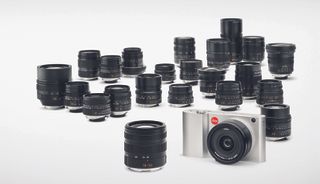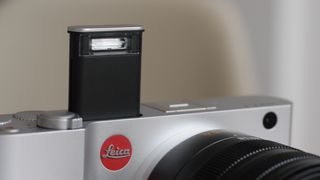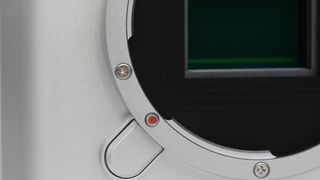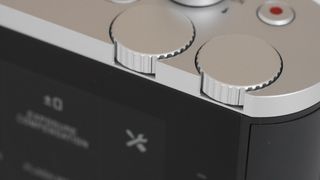Why you can trust TechRadar
The Leica T is much more compact than other Leica models, most notably the Leica M. It's reasonably similar in size and shape to the Panasonic GX7 body, which has a smaller sensor (Micro Four Thirds compared with the T's APS-C sensor).
It's quite a heavy camera, and, having been crafted from a single piece of aluminium, it's very sleek looking too. Even the lugs from which you would hang a strap have been integrated into the body itself to produce very clean lines. If you want to attach a strap you'll need to release the lugs from the body using a pin.
Probably the first thing you'll notice about the camera is the lack of buttons. The rear of the camera is taken up with the touchscreen – although it doesn't take up the whole of the back of the camera so Leica could have included a couple of buttons here if it had wanted to.

Probably the first thing you'll notice about the camera is the lack of buttons. The rear of the camera is taken up with the touchscreen – although it doesn't take up the whole of the back of the camera so Leica could have included a couple of buttons here if it had wanted to.
Instead, almost the entire operation of the camera is carried out via the touchscreen. There are two dials on the top of the camera which control different parameters and that can be customised to your preferred way of working. For instance, while working in aperture priority mode, one will control aperture while the other may control sensitivity, or exposure compensation.
Also on the top of the camera you'll find an on/off switch, a dedicated video record button and the shutter release. If you switch the on/off switch past the 'on' position, the inbuilt flash will pop up. Aside from that, you're completely reliant on the touchscreen.

Most of the time, using the touchscreen is very intuitive, and has been designed to give a great user experience and, crucially, to be appealing to those coming from a smartphone or tablet environment.
Touching a camera icon in the middle right of the screen will bring up all the different options that you'll often want to alter, such as exposure compensation or white balance. As with the dials, this menu can be completely customised to your preferred way of working, with a simple hold and swipe gesture replacing and re-ordering the functions as desired.
Many of the icons you'll see on this screen simply require a tap to jog through the various options available, for instance tapping focus mode will switch between AF and MF. Others will take you to a list, such as white balance, from which you'll need to select the option you need.

As there are no physical buttons, setting the AF point is also carried out via the touchscreen, but you'll need to set AF mode to touch in the main menu. From there you simply the tap the point. It's worth noting that when you have this focus mode selected, you can't half-press the shutter release button to focus – instead you'll need to tap the screen, wait for focus to be acquired and then use the shutter release to take your shot. It seems a bit of an odd sacrifice to have to make for wanting to use the touchscreen to set the AF point, and takes a little getting used to – it's easy to assume at first that the lens simply isn't capable of focusing.
It's also not immediately obvious how you enter playback mode, as this is done by swiping up from the bottom of the screen or down from the top. It's a pretty novel way to work, but once you get used to it, it becomes second nature.

Most of the time, the T's touchscreen is responsive to use, but it's certainly not the most responsive on the market – for instance when swiping through images in playback, it can take more than one swipe for the camera to register movement. As you're left with no choice but to use the touchscreen, this can get quite quickly frustrating.
Although full manual control is available, Leica is aiming this camera at the type of audience that it's not really entered into before, and as such, there's a fully automatic option too, which is designed to make the camera as easy to use as possible.
Amy has been writing about cameras, photography and associated tech since 2009. Amy was once part of the photography testing team for Future Publishing working across TechRadar, Digital Camera, PhotoPlus, N Photo and Photography Week. For her photography, she has won awards and has been exhibited. She often partakes in unusual projects - including one intense year where she used a different camera every single day. Amy is currently the Features Editor at Amateur Photographer magazine, and in her increasingly little spare time works across a number of high-profile publications including Wired, Stuff, Digital Camera World, Expert Reviews, and just a little off-tangent, PetsRadar.
Most Popular







